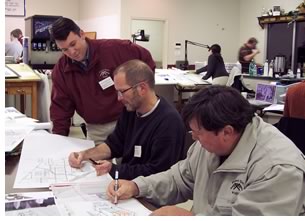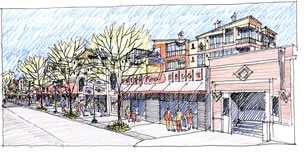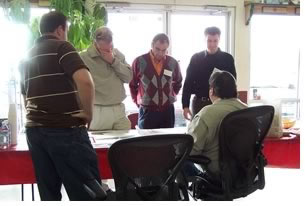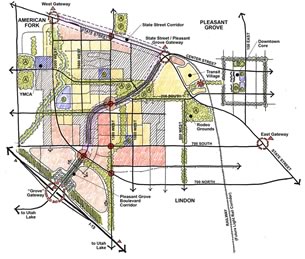

2/2006
137th R/UDAT completed in Pleasant Grove, Utah

by Erin Simmons
Program Manager, Center for Communities by Design
 The AIA Center for Communities
by Design is proud to announce the completion of the 137th Regional/Urban
Design Assistance Team visit. Led by Jerry Ernst, FAIA, a team of eight
professionals volunteered their time and expertise to provide the town
of Pleasant Grove, Utah, with recommendations to help shape the future
of the community. The mission of the team was twofold: Help develop a
long-range plan for the development of a key gateway area leading into
Pleasant Grove and generate suggestions for the revitalization of the
waning historic downtown.
The AIA Center for Communities
by Design is proud to announce the completion of the 137th Regional/Urban
Design Assistance Team visit. Led by Jerry Ernst, FAIA, a team of eight
professionals volunteered their time and expertise to provide the town
of Pleasant Grove, Utah, with recommendations to help shape the future
of the community. The mission of the team was twofold: Help develop a
long-range plan for the development of a key gateway area leading into
Pleasant Grove and generate suggestions for the revitalization of the
waning historic downtown.
 Over the course of four intense days, the Pleasant Grove R/UDAT members
met with government officials, special interest groups, organizations,
and community members to ascertain better the community’s specific
needs and wants. The team developed specific recommendations and produced
illustrations to bring the vision to life. The visit culminated with
a presentation at a public meeting on the night of the fourth day. The
team members wrote and illustrated a report that was made available to
community members at the public meeting.
Over the course of four intense days, the Pleasant Grove R/UDAT members
met with government officials, special interest groups, organizations,
and community members to ascertain better the community’s specific
needs and wants. The team developed specific recommendations and produced
illustrations to bring the vision to life. The visit culminated with
a presentation at a public meeting on the night of the fourth day. The
team members wrote and illustrated a report that was made available to
community members at the public meeting.
 Initiated
in 1967, the R/UDAT program allows local community members to collaborate
with highly skilled professionals who volunteer their time to help communities
foster positive change by identifying and confronting the challenges
that have proven to be obstacles in the past. Based on the principles
of interdisciplinary problem solving, objectivity, and public participation,
R/UDATs infuse communities with a new sense of purpose and vision for
their future.
Initiated
in 1967, the R/UDAT program allows local community members to collaborate
with highly skilled professionals who volunteer their time to help communities
foster positive change by identifying and confronting the challenges
that have proven to be obstacles in the past. Based on the principles
of interdisciplinary problem solving, objectivity, and public participation,
R/UDATs infuse communities with a new sense of purpose and vision for
their future.
Tying past and future together
The R/UDAT team advised the community to reinvest in their historic downtown,
restoring the existing historic structures while constructing new,
compatible buildings that would invigorate the area with new life and
increase the citizen presence and activity. The development of a new
civic center, which would include library, office, and cultural facilities
downtown, would contribute to the revitalization of the downtown area
while providing much-needed community amenities. Additional recommendations
included linking the soon-to-be-developed gateway area with the downtown
by way of an attractive boulevard and creating a revenue-sharing program
to ensure funding for downtown improvements.
 Pleasant Grove residents were enthusiastic about the R/UDAT process
and eager to begin working with the recommendations made by the team.
As Ernst remarked, “The people in Pleasant Grove are wrestling
with issues that will shape their community well into the future. It
was a privilege to lead an extraordinarily talented team of professionals
in articulating a strategy and framework that will enable them to realize
their vision. Our experience in Pleasant Grove was a resounding affirmation
of the value of this long-standing AIA program.”
Pleasant Grove residents were enthusiastic about the R/UDAT process
and eager to begin working with the recommendations made by the team.
As Ernst remarked, “The people in Pleasant Grove are wrestling
with issues that will shape their community well into the future. It
was a privilege to lead an extraordinarily talented team of professionals
in articulating a strategy and framework that will enable them to realize
their vision. Our experience in Pleasant Grove was a resounding affirmation
of the value of this long-standing AIA program.”
With the report and recommendations in hand, Pleasant Grove is now charged with the implementation of the vision developed during the R/UDAT. Members of the team will return to Pleasant Grove within a year to evaluate the progress of the action plan and make additional recommendations to further its successful implementation.
Copyright 2006 The American Institute of Architects.
All rights reserved. Home Page ![]()
![]()
The
members of the Pleasant Grove, Utah R/UDAT team were:
• Jerome Ernst, FAIA, team leader
• James Logan Abell, urban designer
• Jeff Benesi, urban designer
• Lakey Broderius, economic development strategist
• John H. Hooker, AIA, architect/former elected official
• Michael Read, communications graphics
• Thomas W. Rounds, planner
• Philip L. Walker, downtown revitalization consultant.
For more information about the Center for Communities by Design, the
Pleasant Grove R/UDAT, and other community design resources visit AIA.org.
![]()
![]()